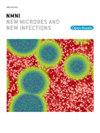儿童急性胃肠炎隐孢子虫的分子特征和系统发育分析:来自伊朗东北部的流行病学见解
IF 5.4
Q2 INFECTIOUS DISEASES
引用次数: 0
摘要
背景隐孢子虫是引起肠胃炎的重要人畜共患病原体,特别是在儿科人群中。本研究旨在调查伊朗东北部急性胃肠炎儿童隐孢子虫的流行情况、分子特征和系统发育分析。方法对2023年1月至2024年6月期间在马什哈德Sheikh医生医院就诊的138名3个月至12岁儿童进行横断面研究。采用Ziehl-Neelsen染色镜检粪便样本,并通过PCR对18S rRNA基因进行分子分析。对阳性样本进行测序,构建系统发育树以评估遗传多样性。结果显微镜下检出隐孢子虫卵囊的检出率为23.2%,分子分析检出隐孢子虫DNA的检出率为26.8%,PCR方法灵敏度较高。测序结果显示,细小隐孢子虫为优势种(14/15份),人隐孢子虫1例。系统发育分析证实了分离株之间的遗传多样性,突出了潜在的人畜共患病和环境传播途径。感染流行率与年龄、性别等人口统计学因素无显著相关性(p > 0.05)。结论分子诊断技术对准确鉴定隐孢子虫种类及了解其流行病学意义具有重要意义。这些发现有助于提高对隐孢子虫感染的区域认识,并强调需要采取有针对性的公共卫生干预措施,以减轻儿童的疾病负担。本文章由计算机程序翻译,如有差异,请以英文原文为准。
Molecular characterization and phylogenetic analysis of cryptosporidium spp. in pediatric acute gastroenteritis: Epidemiological insights from northeastern Iran
Background
Cryptosporidium spp. are significant zoonotic pathogens causing gastroenteritis, particularly in pediatric populations. This study aimed to investigate the prevalence, molecular characterization, and phylogenetic analysis of Cryptosporidium species among children with acute gastroenteritis in northeastern Iran.
Methods
A cross-sectional study was conducted on 138 children aged 3 months to 12 years at Dr. Sheikh Hospital, Mashhad, between January 2023 and June 2024. Stool samples were examined microscopically using Ziehl-Neelsen staining, and molecular analysis was performed targeting the 18S rRNA gene through PCR. Positive samples were sequenced, and phylogenetic trees were constructed to assess genetic diversity.
Results
Microscopic examination detected Cryptosporidium oocysts in 23.2 % of samples, while molecular analysis identified Cryptosporidium DNA in 26.8 %, demonstrating the superior sensitivity of PCR. Sequencing results revealed Cryptosporidium parvum as the predominant species (14/15 samples) with one Cryptosporidium hominis case. Phylogenetic analysis confirmed genetic diversity among isolates, highlighting potential zoonotic and environmental transmission routes. No significant associations were observed between infection prevalence and demographic factors such as age or gender (p > 0.05).
Conclusion
This study underscores the importance of molecular diagnostics in accurately identifying Cryptosporidium species and understanding their epidemiological significance. The findings contribute to regional knowledge on Cryptosporidium infections and highlight the need for targeted public health interventions to reduce disease burden in children.
求助全文
通过发布文献求助,成功后即可免费获取论文全文。
去求助
来源期刊

New Microbes and New Infections
Medicine-Infectious Diseases
CiteScore
10.00
自引率
2.50%
发文量
91
审稿时长
114 days
 求助内容:
求助内容: 应助结果提醒方式:
应助结果提醒方式:


